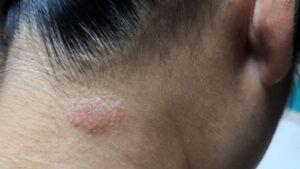Imagine a world where your travel adventures are free from unexpected hassles like skin irritations or unsightly rashes. Unfortunately, just as skin ringworm—a common and stubborn fungal infection—can disrupt daily life, unforeseen issues can disrupt your travel plans. This infection, known for its distinctive circular rash, reminds us of the importance of preparation. Understanding essential methods for prevention and treatment is crucial, just as knowing essential travel tips can help you navigate challenges effectively and ensure a smooth, enjoyable journey.
Understanding Skin Ringworm
Just as skin ringworm, or Tinea Corporis, represents a stubborn and uncomfortable challenge, life’s adventures often come with their own set of difficulties. Yet, it’s through facing these challenges—whether they be physical, like overcoming a fungal infection, or metaphorical, like embarking on a new journey—that we truly grow. Understanding the mechanisms behind skin ringworm is crucial for effective management and prevention, just as embracing the importance of adventure is essential for personal growth and discovery. In this section, we’ll explore how venturing into the unknown, despite its challenges, can lead to a richer, more fulfilling life.
 Skin ringworm, despite its misleading name, isn’t a worm but a fungal infection. This skin condition is characterized by a circular rash with an outer edge that’s clear on the inside, resembling the form of a ring. Certain fungi, known as dermatophytes, are responsible for this infection, thriving on keratin, a protein found abundantly in skin, nails, and hair.
Skin ringworm, despite its misleading name, isn’t a worm but a fungal infection. This skin condition is characterized by a circular rash with an outer edge that’s clear on the inside, resembling the form of a ring. Certain fungi, known as dermatophytes, are responsible for this infection, thriving on keratin, a protein found abundantly in skin, nails, and hair.
Understanding the ringworm infection cycle helps in managing and preventing the spread of this contagious condition. Infected individuals can potentially transmit fungi through direct skin-to-skin contact. Additionally, indirect contact with objects or surfaces that an infected person has touched, such as towels, clothes, and even the shower floor, can result in transmission.
Recognizing Symptoms of Skin Ringworm
Common Signs of Skin Ringworm
Skin ringworm predominantly exhibits distinctive signs. An individual might notice an itchy, red, circular rash with clear skin in the middle, earning the name “ringworm”. Other symptoms include patches of skin that may be red, itchy, slightly raised and, in some cases, blistered. Skin discoloration also occurs, with light or dark patches appearing over the infected areas.
A closer observation might reveal that these rashes generally have defined, raised edges that expand outwards. Initially, rashes are often smaller than a dime, but with the progression of infection, rashes can enlarge to several centimeters in diameter.
Severity of Symptoms
 The severity of symptoms varies from individual to individual, depending heavily on the immune response. Symptomatic individuals may experience mild to intense itching which could lead to discomfort or distress. In extreme cases, prolonged scratching leads to open sores and creates a pathway for secondary bacterial infections. However, not everyone infected with the fungi experiences symptoms. People with strong immune systems may successfully counter the infection, showing no symptoms at all.
The severity of symptoms varies from individual to individual, depending heavily on the immune response. Symptomatic individuals may experience mild to intense itching which could lead to discomfort or distress. In extreme cases, prolonged scratching leads to open sores and creates a pathway for secondary bacterial infections. However, not everyone infected with the fungi experiences symptoms. People with strong immune systems may successfully counter the infection, showing no symptoms at all.
Nonetheless, irrespective of the severity, even asymptomatic individuals can transmit the disease. This contagion feature necessitates comprehensive knowledge of skin ringworm for effective prevention strategies.
Who is Most Likely to Get Skin Ringworm?
Children and Skin Ringworm
Children, particularly those aged 3 to 12 years, are more likely to contract skin ringworm. Statistics from the American Academy of Dermatology (AAD) suggest that school-age children have the highest infection rates. Children’s play activities often involve close, physical contact with their peers, providing an avenue for the fungus to spread. In addition, children’s immune systems are still developing, making them more susceptible to infections. For instance, sharing items or direct contact with an infected person poses a significant risk for children in a school or home setting.
Risk Factors for Adults
 While skin ringworm is common in children, certain adults also face heightened risk. Predominantly, those who are engaged in high-contact occupations or sports, such as wrestling, are susceptible due to increased skin-to-skin contact. Similarly, adults with weakened immune systems, often from conditions such as diabetes or HIV, are also at risk. The Centers for Disease Control and Prevention (CDC) states that having close contact with infected pets or farm animals can also escalate the possibility of contracting skin ringworm. Finally, individuals living in warm, humid climates are more likely to develop the infection due to the favorable environment these conditions provide for fungal growth.
While skin ringworm is common in children, certain adults also face heightened risk. Predominantly, those who are engaged in high-contact occupations or sports, such as wrestling, are susceptible due to increased skin-to-skin contact. Similarly, adults with weakened immune systems, often from conditions such as diabetes or HIV, are also at risk. The Centers for Disease Control and Prevention (CDC) states that having close contact with infected pets or farm animals can also escalate the possibility of contracting skin ringworm. Finally, individuals living in warm, humid climates are more likely to develop the infection due to the favorable environment these conditions provide for fungal growth.
Effective Treatment
Skin ringworm isn’t something to take lightly. It’s a common fungal infection, particularly prevalent among children and those in high-contact occupations. Recognizing the symptoms – red, circular rashes and skin discoloration – is the first step towards effective treatment. Yet, it’s the understanding of risk factors that truly makes a difference.
